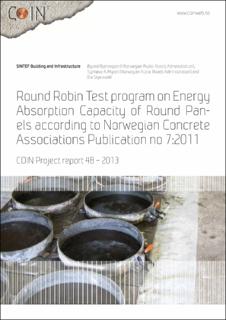Round Robin Test program on Energy Absorption Capacity of Round Panels according to Norwegian Concrete Associations Publication no 7:2011
Research report
Published version
Permanent lenke
https://hdl.handle.net/11250/2826644Utgivelsesdato
2013Metadata
Vis full innførselSamlinger
- COIN Project report [76]
- Publikasjoner fra CRIStin - SINTEF AS [5801]
- Rapporter fra SINTEF Community [790]
- SINTEF Community [2247]
Sammendrag
A Round-Robin test program (inter-laboratory study) on energy absorption capacity of round panels is presented. The panels were tested according to the procedure described in Norwegian Concrete Associations Publication no. 7, 2011 (NB 7:2011). Four laboratories participated in the program:
o SINTEF Building and Infrastructure, Trondheim (SINTEF-T)
o SINTEF Building and Infrastructure, Oslo (SINTEF-O)
o Mannvit Testing and Research Lab, Island (MANNVIT)
o Norwegian Public Roads Administration, Sentrallaboratoriet, Oslo (NPRA)
20 steel fibre reinforced round panels were cast from one single batch of concrete at SINETF-T. The panels were distributed to the three other laboratories, and each laboratory received and tested 5 panels. Testing age for the panels (diameter 600 mm, thickness 100 mm) was 92 days after batching. Standard 28-days compressive cube strength of the tested m=0.45 steel fibre reinforced concrete was 57.8 MPa.
The fibre distribution through the batched 680 litres volume was measured to be very satisfactory; probably related to the fact that the fibres were added directly into the mixer and with thorough mixing after the addition.
The within-lab (repeatability) COV for energy absorption capacity from five panels at each lab varied from 5.5% to 12.2%, and overall average within-lab COV among the four labs was 9.0%. The between-lab variation among the average energy absorption capacity results from each lab was low; the COV was only 4.5%. An estimate on the between-lab reproducibility corresponds to a COV of 10.1 %. These COV-values are in the same range as previous results reported in the literature and must therefore be considered normal and satisfactory.
Among the four labs the average energy absorption capacity varied from 824 Joule to 918 Joule. A typical result from each lab can be expected to be represented by the average result ± the standard deviation (i.e. a confidence interval of 68%). In such case the results overlap, leading to the simple conclusion that the differences among the labs are insignificant.
A panel test is normally reported as the average result of three panels, which is in accordance with NB 7:2011. The present Round-Robin involved five panels at each lab. It appears therefore relevant to consider the ten different combinations of three and three panels that are possible among the five panels. For example, it is notable that for the lab with the highest overall average result (among five panels) all ten average results from the combinations of three and three panels are larger than all the ten combinations from the lab with the lowest overall average result (among five panels). It can be suspected that some of the differences in average results that are seen are of more general character rather than coincidental, but the answer to this could only be found by further Round- Robin tests.
